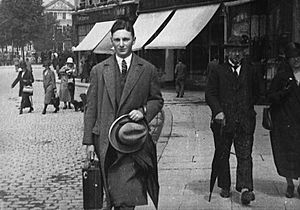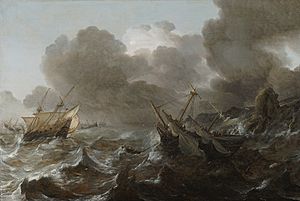Max Stern (gallery owner) facts for kids
Max Stern (1904-1987) was an art collector and dealer who was born in Germany. He was Jewish and had to leave his home because of the Nazi government. He first moved to London, England, and then to Canada.
In Germany, Max Stern owned a famous art gallery called Galerie Stern in Düsseldorf. In 1937, the Nazi government made him close his gallery. Many of his artworks were sold or taken by the Nazis. He then went to London. There, he was held for two years as an "enemy alien," which meant someone from a country that was at war with Britain. Later, he was allowed to move to Canada. In Montreal, he started the Dominion Gallery and helped many new Canadian artists.
Contents
Early Life and Art Career
Max Stern was born in Mönchengladbach, Germany, in April 1904. His father, Julius Stern, was also an art collector and dealer. He had an art gallery in Düsseldorf.
Max studied art in several big cities like Cologne, Berlin, Vienna, and Paris. He earned a special degree from the University of Bonn in 1928. After that, he joined his father's art business. When his father passed away in 1934, Max took over the gallery.
Life During the Nazi Era
When the Nazis came to power in 1933, they treated Jewish people very badly. Max Stern, being Jewish, lost many of his rights because of new laws. He decided he had to leave Germany. He even managed to open a gallery in London in 1935.
The Nazis took away his right to work as an art dealer in Germany. They gave him only four weeks to sell or get rid of all the art in his gallery. His gallery was taken over by non-Jewish owners in 1937. Max was forced to sell many artworks from the Stern Gallery at an auction. These artworks were sold at a place called Kunsthaus Lempertz.
Not all the art was sold. Max put the remaining pieces in storage with a shipping agent. However, the Nazi government later took all of these artworks too.
Max Stern spent several years trying to find the 28 paintings that had been taken from him. He even put an ad in a German art magazine, offering a reward for information. It was very hard to get the paintings back. After the war, the Canadian government helped him get back two paintings: Musical Party by Dirck Hals and Landscape with Figures by Salomon van Ruysdael. Another painting, Last Judgment (in the style of Hieronymus Bosch), was returned in 1954. Sadly, other artworks were never found.
After the War
Max Stern left Germany in December 1937 with only a small suitcase. He hoped to join his sister at her gallery in London. But when World War II started, the British government held him in a camp on the Isle of Man for two years. This was because he was from Germany, an "enemy" country.
Later, the British government allowed him to move to Canada. He sailed on a ship called the Sobieski. He couldn't bring his money or belongings from Britain. In Canada, he was held in special camps in New Brunswick and Quebec for two years. He was given "refugee status," which means he was allowed to stay because he was fleeing danger. He soon connected with William Birks, who helped refugees in Canada, and Mr. Birks supported him.
Because Max Stern knew a lot about art and had experience running a gallery, he became the director of the Dominion Gallery of Fine Art. In 1947, Max and his wife, Iris Westerberg, became the full owners of the gallery. He met Iris, who was from Sweden, at the Canadian Refugee organization.
Together, they made the Dominion Gallery a very important place for showing art by Canadian artists. They were known for helping young and new Canadian artists. In 1944, Max Stern held special shows for artists like Emily Carr and four members of the famous Group of Seven.
Max Stern helped Canadian art in many ways. In the 1940s, he created a system where artists could get monthly payments. In return, they would create a certain number of artworks for the gallery. This helped artists paint full-time. This system has also been used in other countries like France, England, and the United States.
In 1950, Stern moved the Dominion Gallery to a new, larger building in Montreal. This new building had 14 rooms for showing art and an apartment upstairs where Max and Iris lived.
Max Stern's Legacy
After leaving Europe, Max Stern helped people in Canada learn to appreciate art more. He started giving artworks to Canadian museums in the mid-1950s. He was especially generous to museums in Montreal, donating over 166 artworks.
Max Stern passed away in Paris in 1987 while on a business trip.
He received many honors, including a special degree from Concordia University in 1985. The Dominion Gallery stayed open for more than ten years after his death, finally closing in December 2000.
The Max Stern Art Restitution Project was created to find and get back artworks from Max Stern's original collection that were lost during the 1930s. This project is a joint effort by the Hebrew University in Jerusalem, McGill University, Concordia University, and the Holocaust Claims Processing Office in New York. Max Stern's collection had about 400 pieces in total.
In 2016, the project successfully got back two old Dutch paintings: Ships in Distress on a Stormy Sea by Jan Porcellis and Landscape with Goats by Willem Buytewech the Younger.
In 2018, an auction house in Düsseldorf, Germany, returned a painting called Storm at Sea by Johannes Hermanus Koekkoek. This was the 18th painting returned to the Max and Iris Stern Foundation.
In 2019, another auction house, Lempertz, settled a claim related to the forced sale of Happy Family in Garden by Otto Heichert in 1937.
Artworks Donated by Max Stern
Max Stern gave many important artworks to museums. Here are a few examples:
- Painting: Pensive girl. Artist: Prudence Heward. Donated to: The Montreal Museum of Fine Arts.
- Painting: The Flayed Woman. Artist: Paul-Emile Borduas. Donated to: The Montreal Museum of Fine Arts.
- Painting: Little Girl in Blue. Artist: Jori Smith. Donated to: The Montreal Museum of Fine Arts.
- Painting: Woman on a Sofa. Artist: Kees van Dongen. Donated to: The Montreal Museum of Fine Arts.
- Painting: Community House (Ucluelet). Artist: Emily Carr. Donated to: The Montreal Museum of Fine Arts.



